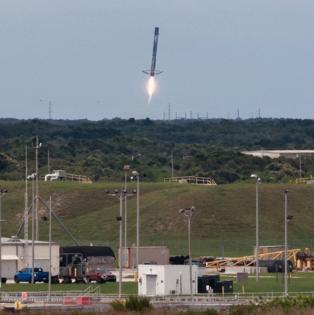SpaceX gets FAA approval to jack up Cape Canaveral's Falcon 9 launches from 50 to 120
Published in Science & Technology News
ORLANDO, Fla. — The Federal Aviation Administration declared Wednesday that a plan for SpaceX to expand its Falcon 9 launch and landing capacity at Cape Canaveral Space Force Station does not require an Environmental Impact Statement.
In March, the FAA posted a draft environmental assessment for SpaceX’s plans to increase launches from Canaveral’s Space Launch Complex 40 from its current limit of 50 per year to as many as 120, while also building out a new landing pad that could handle up to 34 returns of Falcon 9 first-stage boosters annually.
The FAA announced that the proposed increase in launch cadence and new landing site construction were acceptable under requirements set forth by the National Environmental Policy Act, modifying an existing “Finding of No Significant Impact,” known as a FONSI. Had a more stringent Environmental Impact Statement been required, that could have added potentially another two years before moving forward with any construction or operational changes.
A similar environmental assessment is still pending for SpaceX’s operations at Kennedy Space Center’s Launch Complex 39-A for its Falcon 9 and Falcon Heavy launches, where SpaceX also wants to build a new landing pad. That plan calls for an increase from 20 to 36 launches per year and up to 20 booster landings.
Its previous land-based booster recoveries have been at Canaveral’s Landing Zones 1 and 2 located within Launch Complex 13, but already SpaceX has had to cease use of LZ-1 as its lease has run out, and has of late had to rely on LZ-2.
The Space Force wants to shift all launch and landing operations so commercial companies stick to using the same launch complex on the way up as they do the way back down. And the LC-13 site has been set aside as the future launch site for two other commercial launch providers — Phantom Space and Vaya Space — although neither have yet to get a rocket into space.
For Canaveral, SpaceX proposed to build out a 400-foot diameter pad and gravel apron, a new nitrogen gas line, a 30-foot pedestal for post-landing processing and an area for crane storage, adding about 10 acres of development to the site.
Combined, the KSC and Canaveral pads could mean up to 56 booster landings per year, which brings with it the increased frequency for sonic boom warnings for Central Florida. Technically, SpaceX had already been approved for that number of landings from LZ-1 and LZ-2, but its use never approached that limit. SpaceX had 12 booster landings at Canaveral in 2024 and only six in 2023.
So far it has brought boosters back to LZ-1 or 2 eight times in 2025.
SpaceX will still continue to perform most of its booster recoveries on droneships in the Atlantic.
The two SpaceX requests are separate from two other more rigorous Environmental Impact Statements underway by the FAA and the Air Force for potential launch and landing operations for its massive SpaceX Starship and Super Heavy rocket, which for now only launches from Texas.
SpaceX’s Starship plans on the Space Coast are for a launch tower at KSC’s Launch Complex 39-A adjacent its Falcon 9 launch pad and at Canaveral’s Launch Complex 37, where United Launch Alliance had until last year flown its Delta IV family of rockets.
As with all of the reviews, the FAA will still only issue licenses if other factors including safety, risk and financial responsibility are met.
_____
©2025 Orlando Sentinel. Visit orlandosentinel.com. Distributed by Tribune Content Agency, LLC.







Comments